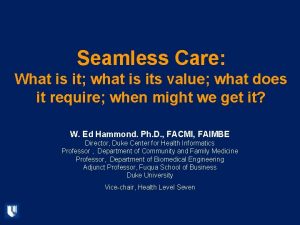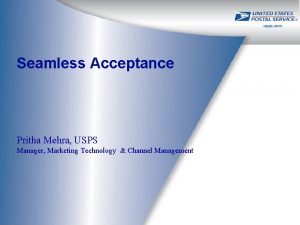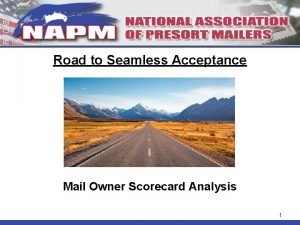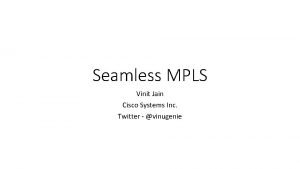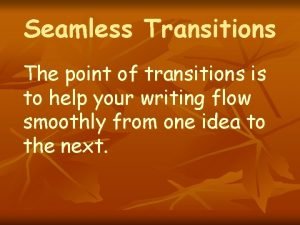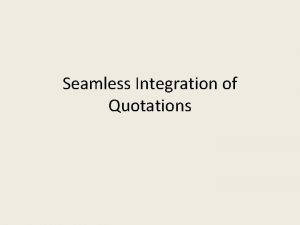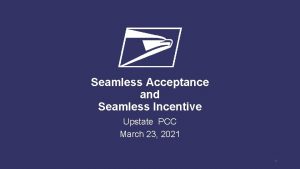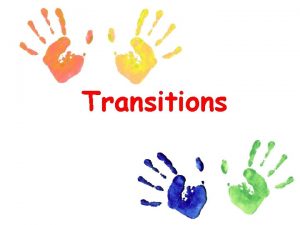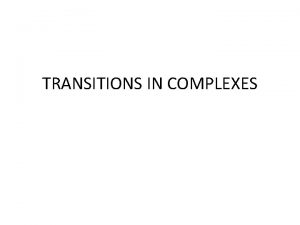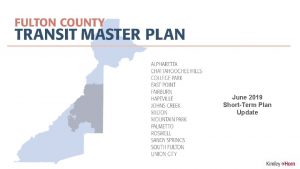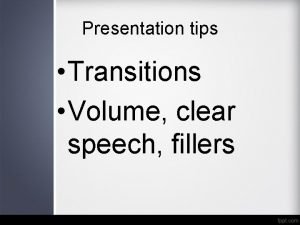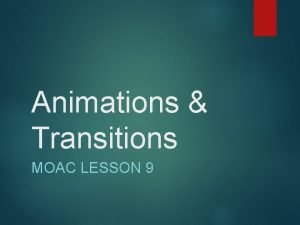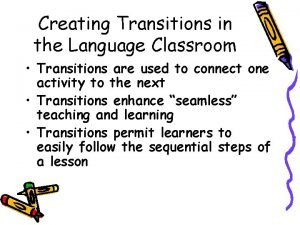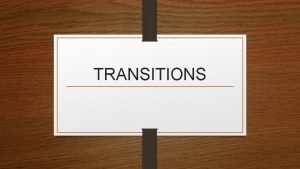Seamless Transitions The point of transitions is to













- Slides: 13

Seamless Transitions The point of transitions is to help your writing flow smoothly from one idea to the next.

Seamless Transitions n n n Transition words and phrases can effectively link ideas in your writing. However, too often, student writers haphazardly plug in transitional phrases from a list at the beginning of paragraphs. These often sound unnecessary and/or unnaturally awkward and can actually interrupt the flow more than help it.

Not-So-Seamless Transitions n n Example: “On the contrary to most cities, Seattle not only has three sports teams including…, but an extravagant aquarium…” Example: “The extended-day schedule would not work here. To illustrate, students just don’t want it here. ”

Seamless Transitions n Even though ideas and reasons in each body paragraph should be distinct, transitions should help readers understand how paragraphs n relate, refer and connect to one another, n and how they work together to build to a larger point.

Seamless Transitions n To effectively, and seamlessly, transition from one paragraph to the next, try repeating a word or short phrase from the previous paragraph early in the next paragraph.

Seamless Transitions n For example, end one paragraph like this: “…Secondly, when students are disruptive in class, the teacher will become very agitated; therefore, unable to teach. Now isn’t it odd that being disruptive and noisy at lunch could lead to all of this mess? You MUST assign seating arrangements so everybody at our school can be stress-free. ”

Seamless Transitions n Start the next paragraph like this: “Stress can result in many happenings: falling behind in school work, acne, and even dropping out of school. You may think stress does not have anything to do with lunchtime, but it does—big time. It is where cliques are made, gangs are joined, and fights are not a rarity but a common occurrence. ”

Seamless Transitions n Example #2, end of one paragraph: “I remember in second grade, having assigned seats, and it was chaotic! Food was thrown, fights started, and sheer pandemonium was evident. Assigned seats were clearly not effective, and actually seemed to make student behavior worse. ”

Seamless Transitions n Ex. #2, start of the following paragraph: “I believe there are more effective ways to get the message across that the current behavior is unacceptable than to tether kids to chairs for the half hour they eat lunch. ”

Seamless Transitions n Example #3, end of one paragraph: “In fact, riding horses can even be your daily mode of transportation. Need something from the store? Outside Mc. Clintock’s Mercantile there’s a hitching post with a watering trough for your trusty steed. ”

Seamless Transitions n Example #3, start of the next paragraph: “Mc. Clintock’s Mercantile is reason enough to live in Luckenbach. This fabulous emporium is like an urban mall, while still having the charm of an old-fashioned general store, which is really what it is. ”

Seamless Transitions Your turn: n n I’m going to pass around a bag. Each student will pick out an object. The first student will say a few sentences about their object. The next student will take an idea from what the previous student said and use it to transition to their object. You can help each other out by trying to end with an idea that can be carried over!

Reflection n n Why did we do this? How could it help us in the exam?


